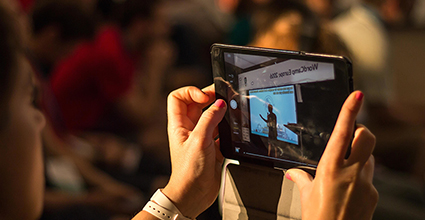Glance down any catwalk worth its salt and you’re sure to find glitzy models and a star-studded front row, hemmed in by lines of eager fashionistas jostling for the clearest view of the latest creations.
But vision has been impaired of late – and catwalk stalwarts aren’t the only ones to suffer.
From the rows of arms holding camera phones aloft at fashion shows to the way that delegates are first and foremost notified of Twitter handles and hashtags at conferences, social media has taken events by storm. With the meteoric rise of live stories (in just one year, Instagram Live Stories has outstripped rival Snapchat by tens of millions of daily users) the gravitational pull towards our smartphones is stronger than ever.
People seem to have developed an addiction to recording and streaming live events, so much so that artists including Alicia Keys and Childish Gambino have literally put the phones of concertgoers on lockdown so they cannot disrupt the show. At WONDER London, we would say all power to them. We all know how it feels to be stuck behind the guy glued to Periscope at our favourite gig.
But at the same time, social media can add value to events if applied in the right way.
To understand how, we first need to reconnect with what events are and what makes them uniquely special as a marketing mechanism. In a world where so many people spend much of their day staring at a screen – where brand messaging is delivered in pixels – events offer face-to-face engagement with people in the physical world. What better way to bring your brand to life than in a real-world environment where people can talk, touch, smell and taste?
To some extent, social media operates in a similar way in the digital space. For the first time ever, brands could communicate one-to-one with people on their own terms. The scope and reach that social media affords brands is unprecedented. What’s more, the fact that new technology like augmented and virtual reality (AR and VR) is bringing a new physicality to digital media makes it all the more appealing. Is it any wonder that brands try to include social media in their events? Why not leverage the likes of Facebook and Twitter to amplify the experience beyond the invite list?
The problem is that when people are encouraged to engage with their personal devices – and therefore the boundless networks attached to them – brands are forcing them to become distracted. With attentions turned elsewhere, delegates simply cannot get the most out of the moment.
Brands must take stock. Instead of being dazzled by digital technology, they must establish why they have chosen to run an event, what the objective is and what they want people to take away from it. Only then should they begin exploring social media (or other forms of digital media) as a means to amplify the experience rather than cancel it out.
Certain brands and industries, particularly visual and creative ones, are in pole position to blend physical and digital live experiences. Burberry, for instance, took a big step forward for fashion when it launched Burberry Live Story on Snapchat to coincide with its SS16 catwalk show. Rather than relying on its elite attendees to spread the word, the luxury brand took social media into its own hands. A pretty clever move, considering the majority of Snapchat users are millennial or younger, meaning Burberry is getting right into the palms of tomorrow’s big spenders. The move made perfect sense.
Live environment and a social media switch-off
The good news is even brands that do not have the budget of a global fashion powerhouse can strike the right balance. But they do so by being pragmatic. Keeping abreast of innovations in social media and the broader digital space, from heavy hitters like VR to more accessible applications like Facebook’s Messenger Broadcast, which allows businesses to send marketing messages direct to users, will mean they are well-informed on what’s out there. After all, each invention could bring exciting new things to the live environment and so there is every reason to get creative, while remaining within the context of the brief. Often teaming up with an agency partner that can dream big and bring innovative ideas to the table, while also acting as a consultant, will help to ensure things remain on track.
There is no doubt that social and digital media are heading in exciting directions. Every day, technology companies launch new products that are tantalising to both brands and consumers. But all-too-often brands are shoehorning social into events, to the detriment of the live experience. Rather than prompting people to rely on gigabytes to capture and store events, brands should instead focus on what matters in the moment. They’ll surely be surprised by the impact they can have.
Have an opinion on this article? Please join in the discussion: the GMA is a community of data driven marketers and YOUR opinion counts.
